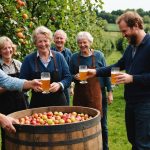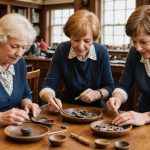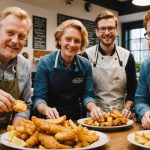Understanding Authentic British Fish and Chips
British fish and chips is more than a meal; it’s a culinary institution with a rich history. The pairing of fried fish and potatoes became popular in the mid-19th century, though both elements were introduced separately. Fried fish was likely brought to Britain by Jewish immigrants from Portugal and Spain, while chips are believed to have originated from Belgium or France. Together, they formed a staple of the British working class, affordable and filling.
The cultural significance of fish and chips in the UK cannot be overstated. During the two World Wars, it provided sustenance amidst rationing, remaining one of the few foods not subject to restrictions. Today, it symbolizes comfort and tradition, often enjoyed at the seaside or on a bustling high street.
In the same genre : Discovering Britain”s Industrial Heritage: A Guide to Touring Historical Landscapes for Travelers
Across the UK, regional variations of fish and chips exist, with Northern England and Scotland sometimes serving the dish with pickled onions or bread rolls. In contrast, southern regions might pair it with mushy peas. The type of fish used can also differ, with cod and haddock being the most popular choices. Each locale adds its unique flair to this quintessential British dish, maintaining its authenticity while also embracing local tastes.
Overview of Immersive Cooking Classes
Immersive cooking classes represent a culinary frontier, transforming cooking into an interactive, engaging adventure. These experiences offer participants a unique blend of education and entertainment, fostering a deeper understanding of culinary arts. Unlike traditional lessons, immersive cooking classes involve hands-on cooking, allowing individuals to actively participate in the cooking process, thereby enhancing the retention of skills.
Have you seen this : Discover the Art of Traditional British Leather Tanning: Interactive Workshops for Visitors
Focusing on specialties like British fish and chips, these classes allow individuals to deeply engage with specific dishes. Participants might start by learning about the history and cultural significance of fish and chips, then proceed to the practical part, where they prepare and cook under expert guidance. This comprehensive approach makes immersive cooking classes a richer experience.
These classes take place in state-of-the-art kitchens, equipped with the latest culinary technology, providing a professional backdrop for learners. Participants gain practical skills, confidence, and even a newfound appreciation for cooking.
Experiencing cooking firsthand encourages participants to experiment, ask questions, and learn techniques they might not encounter otherwise. The atmosphere is often relaxed, fostering a sense of camaraderie among attendees. This not only enhances the enjoyment but also boosts learning outcomes, rendering immersive cooking classes a compelling choice for those looking to expand their culinary repertoire.
List of Top Cooking Classes
If you’re looking to hone your culinary skills in the UK, these best cooking classes offer both fun and expertise.
Location 1: Jamie Oliver’s Cookery School
Kick off your culinary adventure at Jamie Oliver’s Cookery School in central London. Known for its hearty, hands-on approach, this school is perfect for enthusiasts eager to learn traditional British dishes like fish and chips. You will delve into the art of batter-making, perfecting chips, and mastering tartare sauce.
-
Key Learning Outcomes:
-
Mastering quintessential British dishes.
-
Understanding ingredient pairing.
-
Pricing and Schedules:
Classes are priced moderately, starting from £55. They run multiple times a week, ensuring flexibility for any schedule.
Location 2: The School of Artisan Food
Nestled in the Nottinghamshire countryside, The School of Artisan Food champions sustainability and techniques. Their fish and chips classes teach the nuance of batter preparation and frying techniques.
-
Key Learning Outcomes:
-
Mastering traditional techniques.
-
Emphasising local, sustainable ingredients.
-
Pricing and Schedules:
Expect to invest around £175 for an intensive day course, with seasonal schedules to accommodate farm-fresh produce availability.
Location 3: Leiths School of Food and Wine
Situated in London, Leiths offers comprehensive cookery courses. Renowned for its professionalism, it provides detailed instructions on preparing iconic fish and chips.
-
Key Learning Outcomes:
-
Culinary techniques with attention to detail.
-
Plating and presentation skills.
-
Pricing and Schedules:
Classes start at £150, available on weekends, thereby catering perfectly to busy professionals.
What to Expect from the Cooking Experience
In a cooking experience, you’re often immersed in a hands-on learning environment that promotes skill development and enjoyment. Typically, classes are structured to last between two to four hours, providing ample time to delve into the intricacies of traditional recipes. This duration allows participants to fully engage with each step, from preparation to the final presentation of the dish.
Participants can anticipate utilizing a variety of fresh ingredients, each carefully selected to enhance flavour and authenticity in their recipes. It’s common to be provided with basic kitchen tools and appliances, though accumulating experience with specialized tools might occur, depending on the complexity of the dish being prepared.
Cooking techniques form a central pillar of these experiences. You’ll likely explore methods such as chopping, sautéing, and folding, which are crucial to many traditional recipes. Additionally, an emphasis on balance in flavour profiles and presentation highlights the importance of visual appeal in culinary arts.
This hands-on approach not only introduces you to new skills and techniques but also cultivates confidence as you recreate traditional recipes. By the end of the session, many find themselves eager to bring their newfound knowledge and enthusiasm into their home kitchens.
Tips for Tourists Joining Cooking Classes
Embarking on culinary travel can be both exciting and rewarding, but a little preparation can enhance your experience. Curious about what to bring to a cooking class? Start by packing a handy preparation guide. Essentials often include a notebook for jotting down recipes and tips, an apron, and comfortable shoes for hours of standing.
Understanding cultural etiquette is also crucial for tourists. Did you know that in many culinary traditions, it’s customary to express gratitude to your host or chef? A simple “thank you” in the local language can be greatly appreciated. Additionally, following local dining customs, such as the order in which dishes are eaten, demonstrates respect.
You might wonder, what do participants usually experience? Many tourists share stories of vibrant markets, where they learn to select the freshest ingredients. Participants often rave about the communal meal at the end of the class, where tasting becomes a shared celebration of learning and culture.
To fully enjoy these experiences, remain open to new flavours and techniques. Remember, cooking classes are not just about recipes; they are a gateway to understanding a culture through its traditions and tastes.
The Cultural Significance of Cooking Fish and Chips
Cooking fish and chips goes beyond creating a delicious meal; it actively connects communities and celebrates tradition. This beloved dish has become a thread that ties people together, serving as a cultural unifier across various regions. When families gather to prepare and enjoy this timeless dish, they engage in a shared activity that reinforces community bonds.
Through food, particularly fish and chips, traditions are celebrated and maintained. This dish holds cultural significance and is often a centerpiece at local festivals and family gatherings, where the act of cooking and sharing strengthens communal identities. It epitomises a sense of belonging and nostalgia, evoking memories of past gatherings and shared experiences.
Personal anecdotes from chefs and cooking class participants highlight the community’s importance in this culinary tradition. Chefs often recount stories of learning recipes from grandparents, cherishing these passed-down skills with pride. Cooking classes provide a collective environment for participants to share personal stories and cultural backgrounds, enriching the learning experience. As people exchange recipes and techniques, they forge new friendships and deepen their cultural understandings.
Thus, the role of fish and chips in cultural cooking is profound, serving not only as a meal but as a ceremonial thread that weaves through the fabric of community and tradition.
Visual Content and Resources
Visual aids play a crucial role in enhancing the learning experience in cooking classes. By integrating cooking process videos and cooking class photos, students can gain a clearer understanding of techniques and plate presentations. Visual resources help bridge the gap between theory and practice, making complex processes more digestible and approachable.
Cooking process videos enable learners to observe nuanced details that may be missed in written instructions alone. Step-by-step demonstrations, for example, highlight crucial actions such as knife skills, timing, and the correct texture or colour of ingredients at various cooking stages. Such videos can be sourced from platforms like YouTube or streaming services that focus on culinary arts.
Similarly, cooking class photos provide snapshots that capture the essence of each cooking stage. They can be used as references during practice sessions, ensuring learners can visualize the expected outcomes. Platforms like Instagram or Pinterest are rich with user-generated content that chronicles both amateur and professional cooking endeavors.
Utilizing these visual learning resources effectively means integrating them into the lesson plan. Encourage students to review these materials ahead of time and during practical sessions. This multi-sensory approach to learning enhances retention and understanding, making the cooking journey both enjoyable and educational.
Testimonials and Personal Experiences
When it comes to understanding the full impact of our cooking classes on British cuisine, participant testimonials offer invaluable insights. Many attendees express how these classes have been transformative experiences that expanded their culinary horizons. For example, a previous participant mentioned how the course offered a new perspective on the intricacies of British cooking techniques.
Personal anecdotes are filled with reflections on the joys and challenges faced during the process. One story included a memorable moment tackling the nuances of making the perfect Shepherd’s Pie. Such experiences have not only improved the attendees’ cooking skills but also deepened their appreciation for authentic British flavours.
In addition to these personal experiences, class reviews have been glowing. Recommendations from past attendees often emphasise the engaging and informative nature of the classes. A common thread in these reviews is the sense that attendees gain more than just recipes; they leave with practical skills and a genuine enjoyment of cooking.
Through personal anecdotes and class reviews, the consensus emerges: participating in these cooking classes is a culturally enriching adventure that leaves a lasting impression on both heart and palate. If you’re eager to broaden your culinary repertoire, these testimonials suggest that signing up is a decision you won’t regret.















